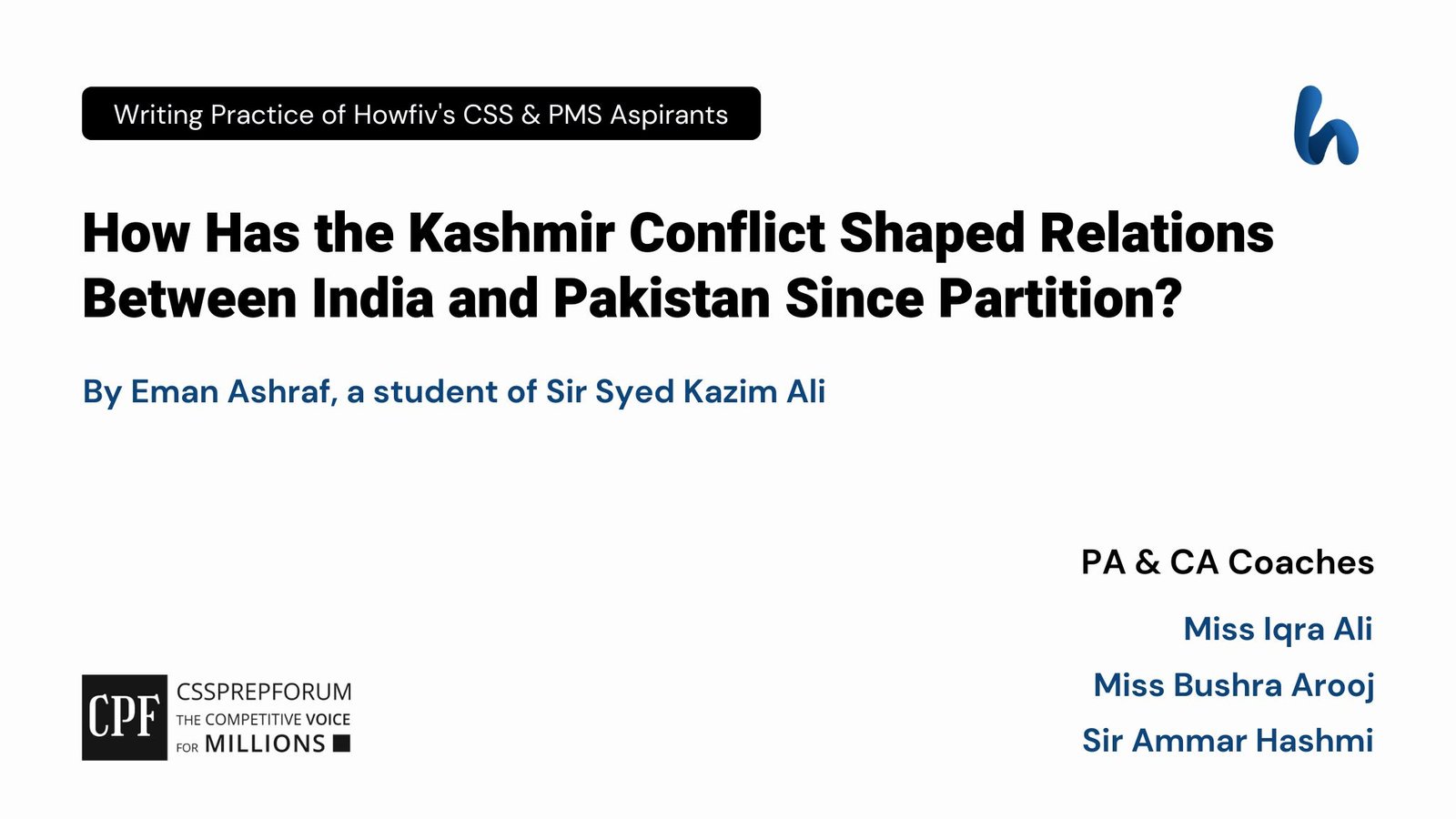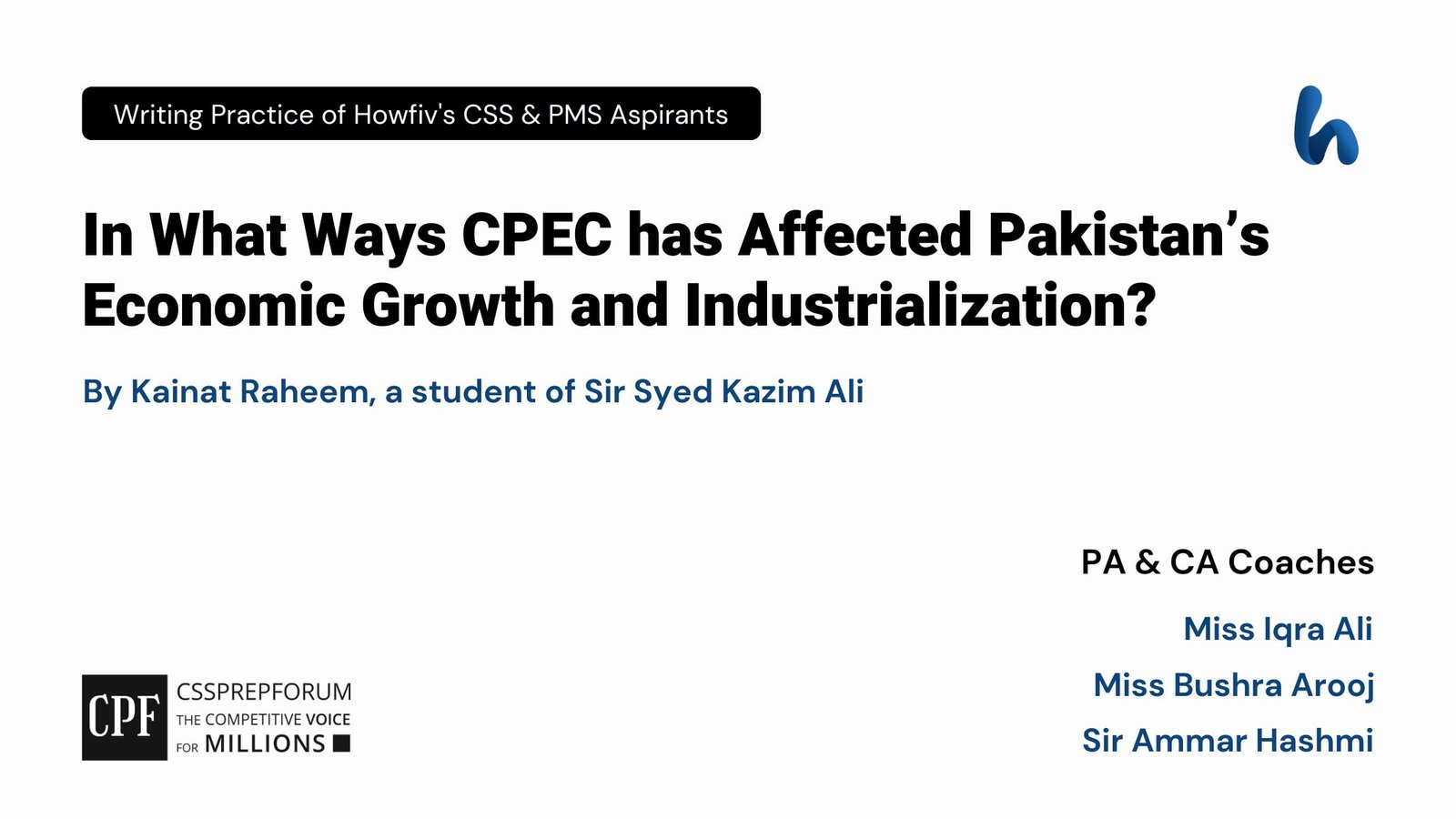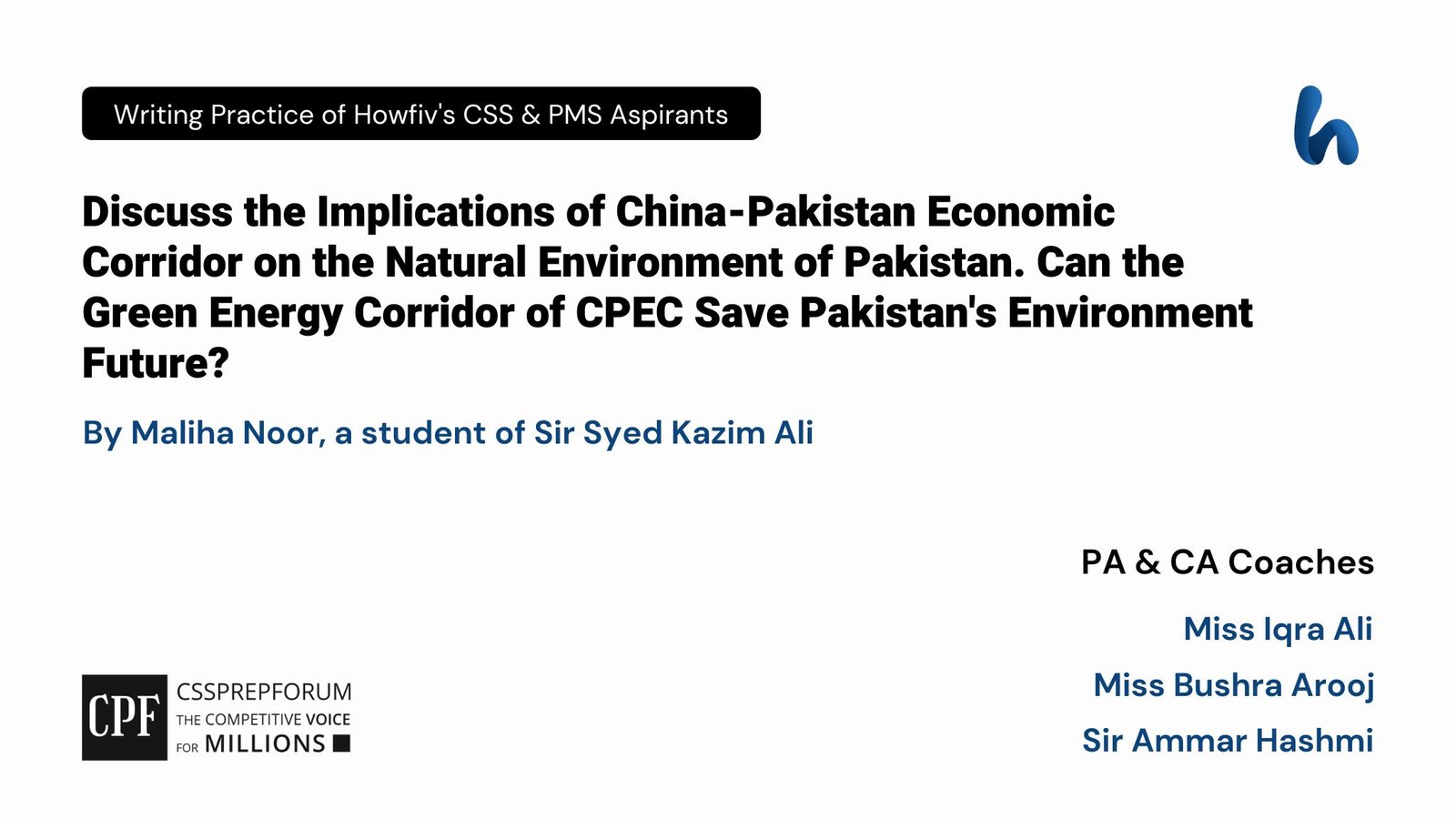Anticipated Military Confrontation between China and The US | Daily Writeup | Opinions
The following article, “In his Third Decade in Power, Xi-Jinping’s Nuclear Buildup with a Significant Focus on AI for Warfare Development is a Testimony to the Anticipation of the Military Confrontation between China and The US that would be the First Great Power War between Two Nuclear Giants. The Consequences of Such a War Will Be Unfathomable, Leaving Many Wondering Who Will Emerge Victorious and How the Dynamics of the Prevailing World Order Will Change. Comment on the Statement. Also, Mention Some Suggestions to Mitigate the Risks of a Potential Catastrophe.”, is written by Laiba Shahbaz, a student of Sir Syed Kazim Ali. Moreover, the article is written on the same pattern, taught by Sir to his students, scoring the highest marks in compulsory subjects for years. Sir Kazim has uploaded his students’ solved past paper questions so other thousands of aspirants can understand how to crack a topic or question, how to write relevantly, what coherence is, and how to include and connect ideas, opinions, and suggestions to score the maximum.

Outline
1-Introduction
2-Xi-Jinping’s nuclear buildup with a significant focus on AI for warfare development anticipating Military Confrontation between China and The US
- Case in Point: in 2019, China’s Defense Paper coined the term “Intelligentized warfare”, predicting the importance of intelligentization and AI as a critical tool for China’s military advancement.
3-Testimony to the anticipation of the military confrontation between China and the US that would be the first great power war between two nuclear giants
- Case in Point: Xi Jinping and Joe Biden held talks during the Asia-Pacific Economic Cooperation summit and discussed re-establishing their military ties and banning the use of AI for military purposes.
4-Who will emerge victorious?
- Case in Point: A doomsday clock is set each year for the Bulletin of the Atomic Scientists, which is decided by analyzing current events and the dangers that could cause a nuclear explosion. And, in 2024, the doomsday clock has reached just 90 seconds from midnight.
5-How will the dynamics of the prevailing world order change?
- Case in Point: Russian President Vladimir Putin highlighted the importance of AI for Russia and the world. Similarly, the US President, Joe Biden, has spent around $6 billion on AI-related research.
6-Suggestions to mitigate the risks of a potential catastrophe
- ✓New international norms and governance systems will need to be developed.
- ✓States should be aware of the emergence of new threats and the damage to the concept of nuclear taboo.
- ✓The decision to use nuclear weapons should be in human hands.
7-Critical Analysis
8- Conclusion

Answer to the question
Introduction
The global landscape of military capabilities is transforming, marked by integrating Artificial Intelligence (AI) into warfare strategies. Verily, the infusion of Artificial Intelligence (AI) and nuclear weapons has the potential to disrupt the conduct of warfare not only for China and the United States but also for all over the world. For example, According to the Rand Corporation, the US-based think tank, Artificial intelligence can potentially cause nuclear war by 2040. China, a prominent player in this evolving scenario, has displayed a remarkable focus on the development of AI for military applications, particularly in the context of nuclear weapons. The fear of a military confrontation between these two atomic giants has prompted efforts by President Joe Biden to engage with China in discussions on re-establishing military ties and imposing bans on AI for military purposes. The urgency of these negotiations stems from the realization that unchecked nuclear weapons modernization, coupled with AI, could lead to a catastrophic conflict. In a scenario where nuclear weapons are involved, predicting a victor becomes absurd, as the consequences would be mutually destructive for all involved parties. Therefore, modifying contemporary rules and regulations according to the emerging challenges and spreading awareness could avoid the potential catastrophe. This article sheds light on Xi Jinping’s nuclear buildup with a focus on AI and the US’s concern about it and its impacts on the dynamics of the world.
“By far, the greatest danger of Artificial Intelligence is that people conclude too early that they understand it.”
Eliezer Yudkowsky
Xi-Jinping’s nuclear buildup with a significant focus on AI for warfare developmen
Starting with China, the country first saw the rapid growth of AI in 2017, and the government first reported it in a document that same year. After that, various AI development plans that represent the use of AI to enhance economic and national power and reveal China’s dream of becoming a leading power in this latest technology have been established. Moreover, before Xi’s era, China had militarized artificial intelligence. In 2019, China’s Defense Paper coined the term “Intelligentized Warfare,” predicting the importance of intelligentization and AI as critical tools for China’s military advancement. According to an estimate by Sweden’s Stockholm International Peace Research Institute, China had 410 nuclear warheads as of January, reflecting a roughly 20% increase within a year. If China maintains its current expansion rate, the US Department of Defense predicts this figure will reach approximately 1,500 by 2035. This abrupt incorporation of artificial intelligence to advance their weapons has become a nightmare for China’s counterpart. Xi has stressed several times, at the 19th Party Congress in 2017 and the 20th National Congress of the Chinese Communist Party (CCP) in 2022, to build a top-class army by the middle of this century. Therefore, China’s efforts to surpass all other nations in the use of disruptive technologies in its weapons and gradual advancement towards the intelligentization of nuclear weapons have become a reason for the strained relationship of China with its counterparts.
Testimony to the anticipation of the military confrontation between China and the US that would be the first great power war between two nuclear giants
After analyzing the direction of winds, it can be seen that the modernization of nuclear weapons has been raising concerns for the United States. For it, US President Joe Biden wanted to renew agreements to impose a ban on manufacturing advanced weapons. For example, Xi Jinping and Joe Biden held talks during the Asia-Pacific Economic Cooperation summit. They discussed re-establishing their military ties and banning the use of AI for military purposes. Thus, Biden’s efforts to secure a deal with China, in this regard, has been a significant step towards the eversion of a nuclear war between these two states, which could happen if both states keep on advancing their nuclear weapons with the combination of disruptive technologies.
Who will emerge victorious?
Due to the modernization of weapons, especially nuclear-related technology, states are getting closer to a devastating war. A doomsday clock is set each year for the Bulletin of the Atomic Scientists, which is decided by analyzing current events and the dangers that could cause a nuclear explosion. And, in 2024, the doomsday clock has reached just 90 seconds from midnight. According to the bulletin, every second has become critical during such dangerous times, and there is an immediate need for concerted action. That’s why, if it is all about the race between military modernizations of nuclear weapons, then no one would be victorious because this race would never end. All game players would struggle to keep themselves splendid regarding their capabilities. Similarly, China and the US, a rising power and a dying one, keep modernizing their weapons with AI. In this way, all states have kept their guns more modernized and efficient to deter their adversaries; artificial intelligence has become the latest addition that can change war dynamics.
Moreover, if nuclear explosions were in a war, it would be absurd to predict the winning state because no one would be left for it. Today, it is not fair to analyze the contemporary adversaries and conflicts between nuclear weapon states with the one that happened in 1945. In 1945, the United States, a nuclear weapon state, first time used atomic weapons in two cities in Japan, a non-nuclear weapon state, causing unforeseen devastation in these cities. Today, the world has become more dangerous, with nine nuclear weapon states having thousands of mighty nuclear weapons with advanced technology. Now, every single conflict or war raised the possibility of the use of atomic weapons; moreover, both sides started strengthening their muscles by spending a large chunk of their budgets on defence capabilities. As a result, the chances of nuclear war have increased. If there were a nuclear war between China and the US, undoubtedly, it would be a third nuclear war because of the involvement of two nuclear superpowers located in the east and west of the world. More states as allies would join the war, resulting in atomic havoc with none as a victor.
How will the dynamics of the prevailing world order change?
China and several other developed states have been advancing their military use of Artificial Intelligence. World leaders have been insisting on the importance of AI for future warfare. For example, Russian President Vladimir Putin highlighted the importance of AI for Russia and the world. Similarly, the US President, Joe Biden, has spent around $6 billion on AI-related research. Lastly, China dreams of having a modernized and intelligentised military by 2050. This shows a shift in the dynamics of the prevailing world order. AI can make decisions without human involvement, which will lead the world to potential disaster as there will always be a possibility of misunderstanding or technical failure. It means the world has to deal with a leader’s irrational thinking and machine error machines securing their lives. Despite the decision-making process in the hands of AI and the risk of machine error, there is also the threat of cyber-attacks from adversary states. Moreover, proliferation risks of such technology have already been observed. These things have been harming the international norms and governing system. Thus, the future will belong to the state superior in artificial intelligence, and that state’s behaviour will decide the war and peace of the world.
Suggestions to mitigate the risks of a potential catastrophe
The formation of new International norms and governance systems would be required to meet the challenges emerging from advancing defense capabilities and mitigate the risks of a potential catastrophe. Contemporary rules and regulations have become outdated and unable to deal with disruptive technologies. For example, in 2021, Israel disrupted the spinning of uranium enrichment of a nuclear power plant with a cyber-attack in Natnz, Iran. Israel accepted responsibility for this attack; however, in most cases, it is impossible to figure out who attacked the power plant. Thus, AI would make it possible to start a nuclear war from anywhere in the world just with the help of a computer virus. As a result, the fastest-growing technology demands immediate and decisive rules and regulations. The regulatory framework for AI by the European Union, the US’s international declaration to address AI risk, and the UN advisory body are precursors to the requirement of more solid frameworks. Moreover, states must be aware of new threats and associated challenges. Leaders of developed states are still unable to accept the fact that the nuclear taboo, established for 70 years, has been significantly harmed. Last but not least, the decision to use atomic weapons must remain in human hands. It would save the world from potential catastrophe.
Critical Analysis
Critically, it is still early to say that a nuclear war between China and the US is soon going to happen because of the use of artificial intelligence in atomic weapons. As for now, China is moving towards integrating AI with nuclear weapons to improve its capabilities, but still, it is not entirely successful in its objectives. Thus, the future of humanity could be saved now, and it is in the hands of rational leaders and depends upon their rationality. After the militarization and nuclearization of artificial intelligence, new avenues and possibilities of war will emerge. That kind of war would be more lethal and unable to stop; moreover, no one would be victorious after a devastating nuclear war. Consequently, international cooperation is immediately needed to deal with the emerging challenge.
Conclusion
In conclusion, the evolving landscape of artificial intelligence (AI) integration into China’s military, particularly its nuclear weapons program, introduces a complex and potentially perilous dynamic in international relations. The militarization of AI, called “Intelligentized warfare,” signals a shift in global power dynamics. The urgency for international cooperation is evident, as reflected in the efforts of leaders like Joe Biden to renew agreements and address the use of AI for military purposes. As nations race to modernize their weapons, the need for robust international norms and governance systems for AI becomes paramount. Mitigating the risks of a potential catastrophe requires a reevaluation of existing regulations and the establishment of new frameworks. Recognizing the role of human decision-making in the use of nuclear weapons is crucial. While initial steps have been taken, the journey towards effective rules and norms governing AI is ongoing and necessitates concerted global efforts to ensure a secure and peaceful future.

CSS Solved Past Papers’ Essays
Looking for the last ten years of CSS and PMS Solved Essays and want to know how Sir Kazim’s students write and score the highest marks in the essays’ papers? Then, click on the CSS Solved Essays to start reading them.
CSS Solved Essays
CSS Solved General Science & Ability Past Papers
Want to read the last ten years’ General Science & Ability Solved Past Papers to learn how to attempt them and to score high? Let’s click on the link below to read them all freely. All past papers have been solved by Miss Iqra Ali & Dr Nishat Baloch, Pakistan’s top CSS GSA coach having the highest score of their students. General Science & Ability Solved Past Papers












